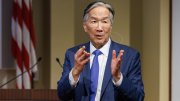In an e-mail preceding yesterday's final regular Faculty of Arts and Sciences (FAS) meeting of the semester, and in discussion at the meeting itself, Dean Michael D. Smith reported preliminary financial results that indicate further progress in reducing that faculty’s deficit. For fiscal year 2011, ending June 30, Smith projected a deficit in unrestricted funds of $16 million, compared to the initial budgeted deficit of $35 million. The red ink—which he characterized as "structural" in his remarks to colleagues, and therefore carrying over into fiscal 2012—is being covered with FAS reserve funds; obviously, the better-than-budgeted shortfall means that those reserves will not have to be tapped so heavily.
In his e-mail, Smith attributed the gain to diverse factors: continued efforts to find appropriate ways to use restricted funds, particularly in FAS's many freestanding academic centers, to support core faculty, teaching, and research missions; savings in use of utilities; and increased unrestricted, current-use giving from alumni. In his remarks, he also cited savings from the College, athletics, and other large operations, and gains ranging from the opportunistic (reduced debt service) to planned, long-term improvements in information technology and other costly administrative services.
"With continued discipline throughout the organization and absent a downturn in the economy or changes to University guidance [on future endowment distributions, which are scheduled to begin increasing in fiscal 2012]," he wrote, "we are on track to eliminate the remaining structural deficit by the end of FY12. Though this will not return us to pre-crisis levels of funding, it will mean that normal financial vigilance will replace our recent focus on budgetary reductions." (At the direst moment, Smith had forecast an unrestricted operating deficit of $220 million, had FAS not temporarily eliminated compensation increases; reduced staff; curtailed faculty expansion; reined in capital spending; and benefited in ways then unforecast from increased giving and changes in certain endowment-funding formulas.)
In a modest, tangible celebration of FAS progress, he was able to resume serving cookies, along with tea and coffee, at the meeting after a two-year hiatus.
Smith told the faculty that the year now ending had, as anticipated, been the most difficult one financially for FAS, given two years of reductions in the endowment distribution, its largest source of revenue. FAS, he said, had navigated the challenges while maintaining the faculty's size; enhancing graduate-student financial support somewhat and (in the current year) modestly increasing the size of the graduate student body; and sustaining and expanding undergraduate financial aid.
Eliminating the deficit in the coming year would, he said, be challenging, but he anticipated enough financial flexibility to enable "strategic investments" in information technology and in the libraries—where long-term cost savings and service enhancements are considered especially significant—and in staffing up the development organization for the forthcoming University capital campaign, which is expected to be the principal means by which FAS can again pursue its largest educational and research objectives. In concluding his e-mail, Smith wrote, "[T]he accomplishments of the past three years now allow us to fully shift our attention to our mission of teaching and research, setting intellectual priorities and charting actions in a manner that is informed by, but not dictated by, our financial resources. This is the path of sustainable excellence, the path that allows us to robustly pursue our shared aspirations."








